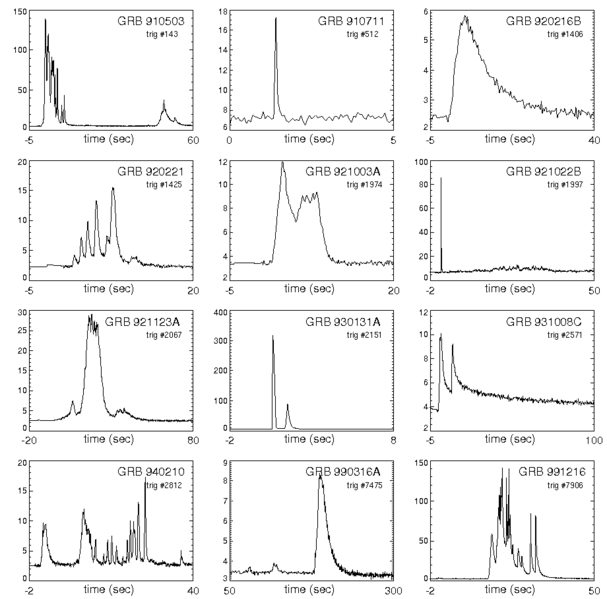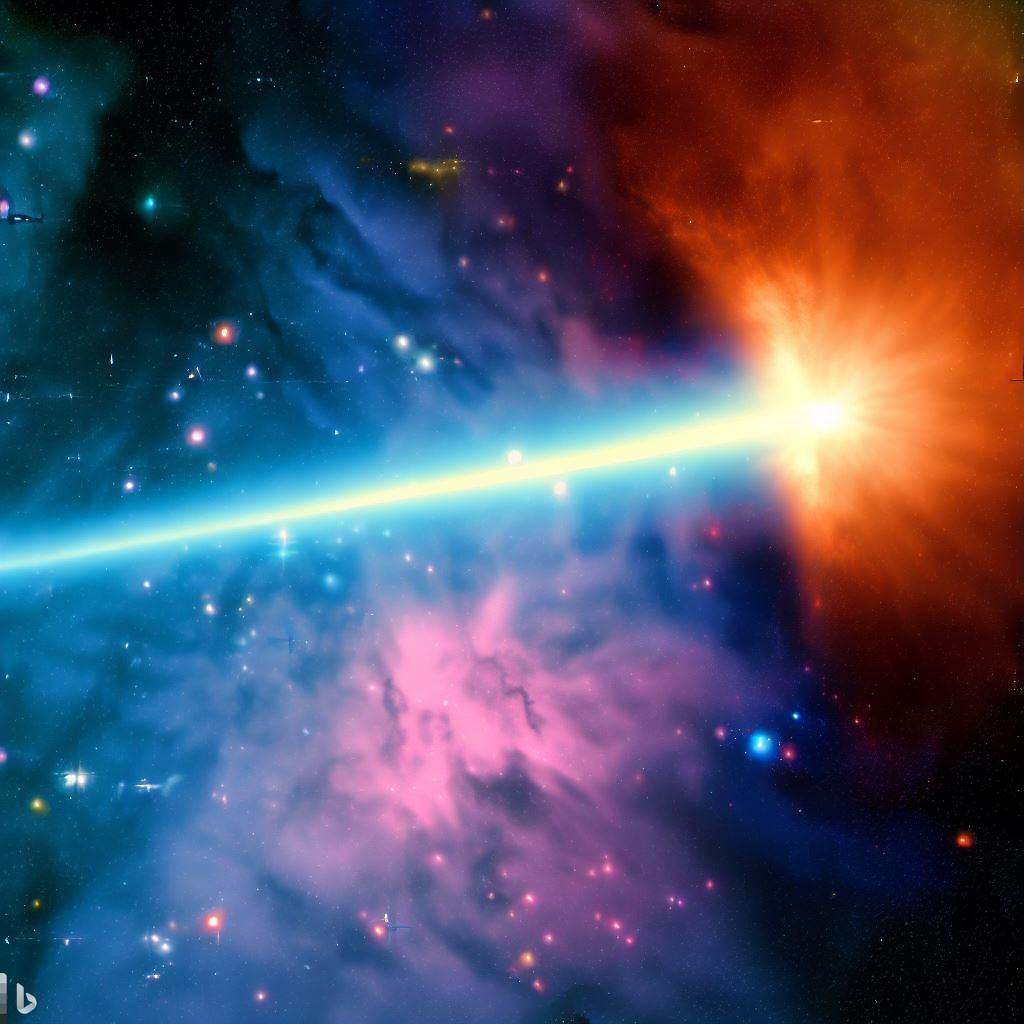Gamma Ray Bursts are highly energetic beams emitted from the explosions of a dying star, which in turn results in the birth of either a black hole or a neutron star. These luminous electromagnetic events are some of the most energetic events known to us next to the Big Bang. Some of these bursts can last a few milliseconds, while others may survive for several hours based on the origin of that GRB. During a GRB, a highly concentrated beam of gamma rays is shot from the poles of the star’s explosion. This beam slowly fades into weaker electromagnetic waves, which astronomers call the afterglow. The recorded sources of these GRBs are billions of light years away from our planet, making their scale of emitted energy tremendously powerful.

History
During the Cold War, the US and the USSR signed the Nuclear Test Ban Treaty after witnessing the burning and heart-wrenching aftermath caused by the use of nuclear weapons. The US suspects the USSR of conducting space nuclear tests and sent satellites Vela 3 and Vela 4 to spy on the state. But the satellites showed readings that were unlike any nuclear tests. The nature of the readings made it quite obvious that no country could have been blamed for these observations; they were something previously unknown to humans. Astronomers believed these could be the effects of a closer white dwarf, pulsars or other alternatives, but it could not be proven so. Observations from acute positioning with spectrometer devices concluded that these GRBs originated from distant galaxies.
In 1997, astronomers detected a gamma-ray burst (GRB 970508) within four hours of its appearance. This early observation allowed the researchers to make a study about it better. The spectrum of this GRB was revealed with a redshift of 0.835, making it roughly 6 billion light years away from our planet. Such a revelation proved that GRBs are energetic beams capable of traversing billions of light years through space. Such events whose origins are from faint galaxies at enormous distances are named extragalactic events. The following year, a gamma-ray burst GRB 980425 was detected after a supernova with the same origination point. This lets the researchers conclude their origins from the cries of dying stars or the birth of black holes.
How far is a GRB?
During the early stages of observing GRBs, their distance of origination is estimated by the amount of redshift in the wavelength of light observed. Consider the GRB 970508 mentioned above, with a proposed 6 billion light years from our planet, which had a redshift of z=0.835. For smaller values of ‘z’, (z«1 or by neglecting the effects of the expansion of the universe and the density of matter in space) we can use the approximated formula as
\[z = \frac{\Delta \lambda}{\lambda_{rest}}\] \[= \frac{\lambda_{obs} - \lambda_{rest}}{\lambda_{rest}} = \frac{v}{c}\]$z = v/c$. (Definition of redshift) $v = Ho.d$ (Hubble relation of distance and the velocity of the object; 46,200 mph per million light-years) Combining both equations, we get. $d = z.c/Ho$.
Placing the available values, we get d = 12 billion light years. (This is just the result of our ideal condition in space and hence such an enormous error) For z closer to 1, the neglected factors come into play, complicating the Hubble relation non-linearly.
Even though these calculations and methods have been the basis of a lot of research, the question always arises whether it applies to these bodies and give accurate readings. As it turns out, it may not be the case for all the celestial bodies to follow a singular law. This argument has been supported by a few research, which suggest a deviation, or rather independence in the behaviour of these GRBs from the conventional law being used by most of the roomers. After rigorous experimenting on various methods utilising the data recorded from experiments, it was concluded that there was no one fit to give a definite relation between a GRB and its redshift. Hence, as an alternative approach, astronomers began to use the afterglow emitted after the main burst to determine its distance. The afterglow is the longer-lived emission at longer wavelengths (X-ray, ultraviolet, optical, infrared, microwave and radio) that follows the initial flash of gamma rays. The intensity of the burst is mapped with time and is called the light curve.
\[m-n = 2.5 \log(\frac{P_m}{P_n})\]Here, m and n are the Apparent magnitudes, with the measured Fluxes represented by Fm and Fn. An average GRB has a bolometric flux (the apparent brightness when viewed at a distance 10 parsec away from Earth) that does not change with distance. Whereas the GRB, for example, GRB 080319B, had an apparent brightness of 5.8 magnitudes. For reference, the range of what a naked eye can notice in the night sky is +6. This allows us to calculate its distance from the luminosity-distance relation, which gives us over 7.5 billion light years away from Earth. It is important to note that this method assumes that the intrinsic luminosity of the GRB is known, which is not always the case.
Classification
Although just composed of gamma rays, the light curves of GRBs are so complex that no two of them are identical. The duration of each GRB can range from a few milliseconds to tens of minutes, with single or several sub-pulses, with either fast brightening or slow fading. Several attempts have been made to classify these GRBs, the only identifiable distinction being the duration for which they last: the two classes being either a very short GRB explosion or a very large one. However, these two distinctions are also not very clear with a clear overlap region of GRBs.
Short gamma-ray bursts:
These GRBs have a duration of less than about two seconds. They account for about 30% of gamma-ray bursts. The fact that they were so short-lived did not allow astronomers to observe the afterglow until 2005, thereby causing their origins to remain unclear. After 2005, several short GRBs have been detected and localised. These GRBs originate from regions with little to no star formation, such as large elliptical galaxies. According to some astrophysicists, these short GRBs have a different origin than massive stars and have no relation to supernovae events, while Others proposed this origin from another type of explosion called kilonovae, resulting from the merger of a binary neutron star or a neutron star with a black hole.

Long gamma-ray bursts
These are the widely observed GRBs from the sky, with about 70% of all observed GRBs. These GRBs last more than two seconds, which allows astrophysicists to study them to a greater extent and it is undebated that these GRBs originate from galaxies with rapid star formation. They emerge from the death of massive stars during a core-collapsed supernova. However, this is not the only origin for them, with the first kilonova explosion to produce a long GRB from a neutron star merger being recently recorded in December 2022
Ultra Long gamma-ray bursts
These are the events at the end of the long GRB, lasting longer than 10,000 seconds. They have been categorised separately due to them originating from the collapse of a blue supergiant star, a tidal disruption event or a newborn magnetar. Some of the popular, well-studied recorded rays in this class are GRB 101225A and GRB 111209A. Their observation rate is low due to the current instruments employed, which have low sensitivity to long-duration events. Some studies even negate the separate classification, and that further multi-wavelength observations need to be made before concluding.
Energization
For an event such as a GRB to be observable at this distance, it must have an extremely energetic source. The energy of a GRB is mostly in the form of gamma rays, with some exceptions having powerful optic counterparts. Numerically, it is calculated by studying its light curve, which is a graph that shows the brightness of the burst over time. It is done based on a simple analysis and further calculations. For example, consider the GRB 080319B, which has an incredible optical counterpart, even visible to the naked eye. For this GRB, assuming the gamma rays are spherically distributed, the energy output would be around two times the rest mass energy equivalent of the Sun. which means the energy emitted if the Sun converts entirely to radiation.

However, there is a catch in this if the radiations for the GRBs are distributed spherically, the earth would have been hit with several gamma-ray bursts, which is certainly not the case. Astrophysicists claim these Gamma Ray Bursts are highly focused explosions, with the energy of the entire burst concentrated on a narrow jet. The angular width of the jet beam is estimated by observing achromatic jet breaks in the afterglow light curves. The time after the slow decaying of the afterglow begins to fade rapidly. The observed time of the afterglow jet break after the prompt GRB contains information about the angular size of the outflows that produce these transients; general observations suggest that most jets have an angular width between 2 to 20 degrees. Since these are narrow beams, they appear much brighter than how they would look for a spherically emitted GRB. This concludes that the energy from the GRB to around 1/2000 solar mass energy equivalent. The angular width of short GRBs is not measured accurately because they are less luminous than long GRBs and have a concise duration. This leaves us pondering whether they are less likely to collimate or not collimated at all.

Effects on Earth
To this date, the detected GRBs have not proved fatal to us, mostly because all of them originated quite away from the Milky Way. However, if we are to witness a GRB directed towards us within 5,000 to 8,000 light-years away inside our galaxy, then the effects could be harmful and potentially devastating for our ecosystem. The potential situation of a GRB hitting the Earth would cause the formation of nitrogen dioxide in the atmosphere, which will destroy the ozone layer, and the excess of it will be washed on Earth as highly toxic acid rain. In the long run, the smog may settle down and possibly cause the cooling of the planet, leading to a cosmic winter that would last for years.) One such event is also hypothesised to be the cause of the Ordovician- Silurian extinction event around 450 million years ago. However, there is no accurate model to predict the possible occurrence of such events, as that would require information to travel faster than the speed of light. Based on the developments of today, we can only observe GRBs after they take place. And Earth being in the outskirts of our galaxy at some of the lowest density regions, makes it one of the safest environments in our universe.
References
Teach Astronomy - Relating Redshift and Distance
Host Galaxy or Background Galaxy (arxiv.org)
Brightness, Luminosity and Flux of Stars Explained, Perfect Astronomy
